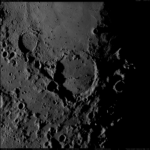[3D-Model by Marco Campaniello]
Thanks so much to my friend Marco Campaniello for 3D-Model computation of the image
Italian:
Il cratere lunare Fracastorius, intitolato al fisico italiano Girolamo Fracastoro, è un grande cratere di 120,58 km situato nella parte sud-orientale della faccia a noi visibile della Luna, sul confine meridionale del Mare Nectaris, ed è quanto rimane di un antichissimo impatto ormai ricoperto di lava.
A nordovest di questa formazione si trova il cratere Beaumont (in alto a sinistra di Fracastorius, molto eroso), mentre a nordest si trova il cratere Rosse (molto più piccolo, in alto leggermente a destra di Fracastorius, col fondo totalmente in ombra e con un lungo cono d’ombra che si prolunga fin sul lato buio, non illuminato, della Luna).
La parete settentrionale del cratere è stata completamente erosa e l’unico resto sono alcune piccole collinette all’interno del mare lunare.
La lava che ha dato origine al Mare Nectaris ha invaso anche il cratere, quindi la struttura visibile oggi è simile a una baia. Ciò che resta del bordo è pesantemente eroso e ricoperto da impatti minori successivi e soltanto rare sezioni sono ancora oggi intatte. L’altezza massima del bordo del cratere è di 2.400 metri.
Il più notevole dei crateri minori è “Fracastorius D”, che occupa una consistente parte del bordo occidentale di Fracastorius.
Fracastorius non ha alcun picco centrale ma solo delle colline, ed una lunga e bella rima che passa attraverso il centro del fondale in direzione est-ovest.
Dettagli tecnici:
Telescopio Astrofaktorja DK20″ @ ~ F/27 – Player One Saturn M camera – TeleVue Powermate Barlow 2x – Baader R filter (~580nm) – Seeing ~ 6,5/10 (max.) in R band – sito: Palermo @ my personal Observatory.
****************************************************************************************************************************************************
English:
The Fracastorius lunar crater, named after the Italian physicist Girolamo Fracastoro, is a 120.58 km wide crater located in the south-eastern part of the visible face of the Moon, on the southern border of the Mare Nectaris, and is all that remains of an ancient impact now covered with lava.
To the north-west of this formation is the Beaumont crater (top left of Fracastorius, very eroded), while to the north-east is the Rosse crater (much smaller, top slightly to the right of Fracastorius, with the bottom totally in shadow and with a long cone of shadow that extends to the dark, unlit side of the Moon). The northern wall of the crater has been completely eroded and the only remnant are some small hills inside the lunar sea. The lava that gave rise to Mare Nectaris also invaded the crater, so the structure visible today is similar to a bay.
What remains of the rim is heavily eroded and covered by subsequent minor impacts and only rare sections are still intact today.
The maximum height of the crater rim is 2,400 meters. The most notable of the minor craters is “Fracastorius D”, which occupies a substantial part of the western rim of Fracastorius.
Fracastorius has no central peak but only hills, and a long and beautiful rhyme passing through the center of the seabed in an east-west direction.
Technical details:
Astrofaktorja DK20″ telescope @ ~ F/27 – Player One Saturn M camera – TeleVue Powermate Barlow 2x – Baader R filter (~580nm) – Seeing ~ 6.5/10 (max.) in R band – site: Palermo @ my personal Observatory.


